Affiliate disclosure: This post may contain affiliate links. Please see our Privacy Policy.
Lonzino is a simple home-cured pork recipe that’s perfect for beginners. Just a few ingredients and you’re well on your way to homemade charcuterie!
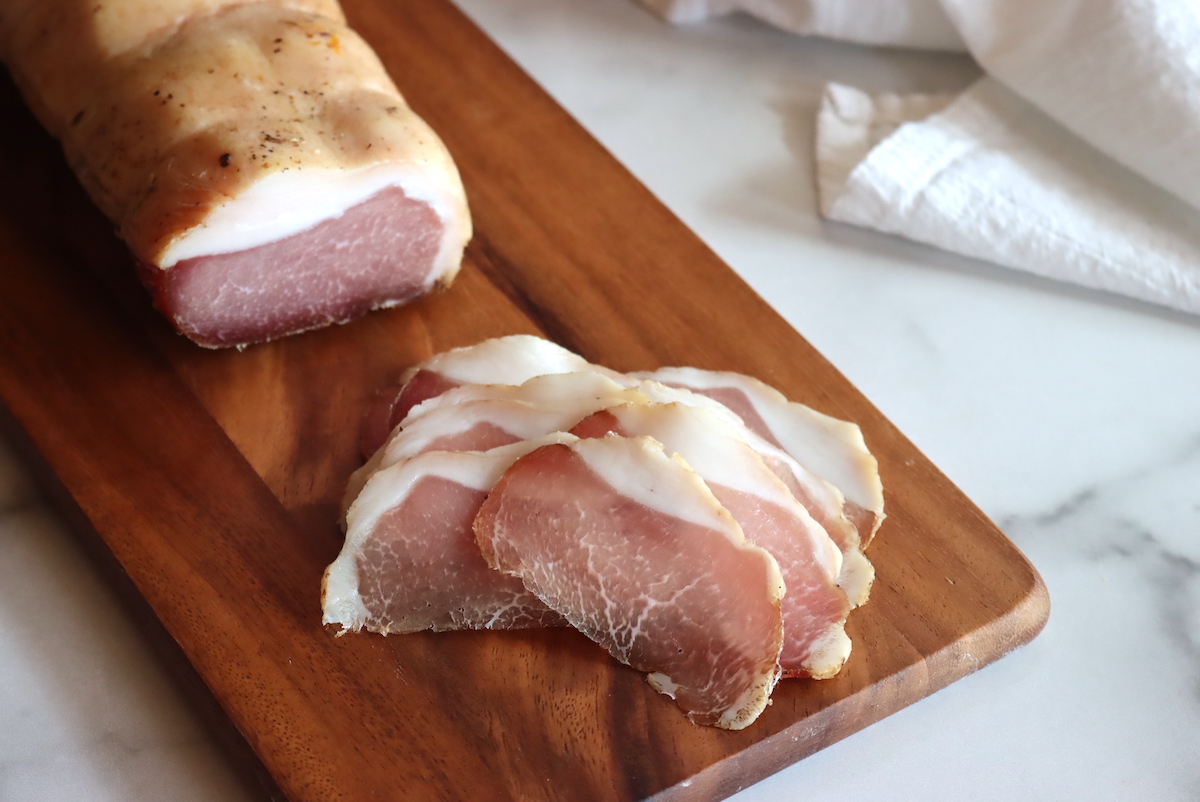
Lonzino is one of the easiest dry-cured meats to make at home, and it’s made with a simple pork loin. No complicated cuts or equipment, nothing too fancy seasoning-wise…but the results are absolutely phenomenal.
The hardest part about dry curing meat is creating the right conditions for curing, both in terms of temperature and humidity. These days, there are specialty charcuterie wraps that help control humidity automatically, which means that it’s incredibly easy for anyone to make charcuterie at home.
Start with high-quality meat, plus salt, seasoning, and a good bit of patience. The end result is absolutely magnificent home-cured meat, even if you’re an absolute beginner.
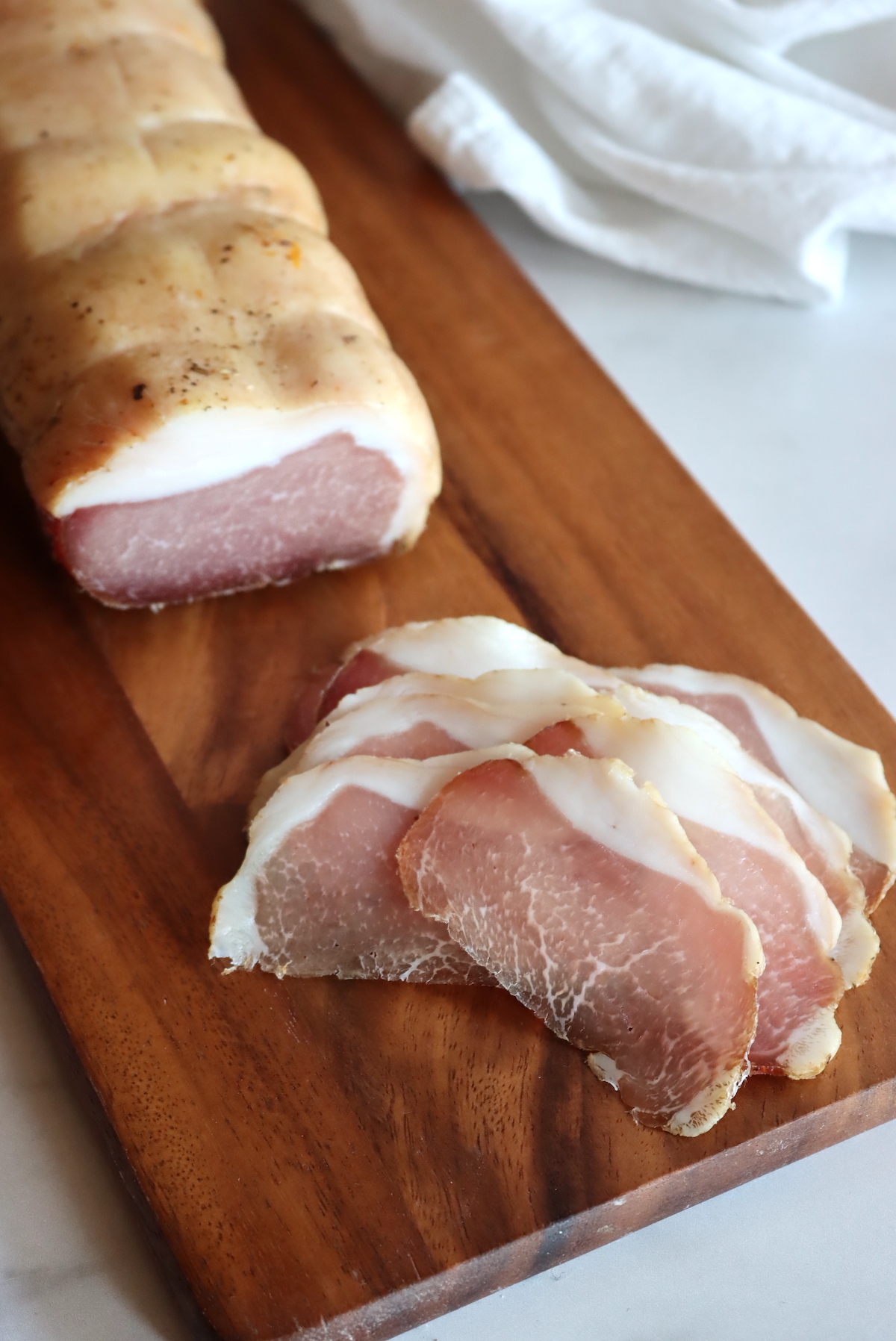
What Is Lonzino?
Lonzino is a cured pork loin, with or without the fat cap attached. The meat is first cured in salt and seasoning for 7 to 10 days, and then it’s hung to air dry for 3 weeks to as long as 6 months.
The end result is a richly flavorful cured meat that’s perfect for slicing thin and displaying on a charcuterie platter.
This particular cured meat is known by many names throughout the world. Lonzino is its name in Italian, where it’s commonly made with citrus and fennel. It’s sometimes called lonza, and is either made by curing the loin or tenderloin.
Lomo is the Spanish version, and that’s most often cured with paprika.
Other regions have different names but similar techniques. In Corsica, Cyprus and Grece it’s called its lonzu or lountza, and the cures often include red wine.
Ingredients for Lonzino
The most important ingredient in lonzino is the actual cut of meat.
The loin is generally a lean, tender cut that’s perfect for high heat. It’s tender, but not all that flavorful on its own, especially since it’s usually a very lean cut without much internal marbling.
I do not suggest using just any piece of factory-farmed pork loin from the supermarket, as those cuts are a recipe for disappointment. Opt for a heritage breed, which is more flavorful generally, and tends to have more natural marbling.
Local farms around my area don’t sell whole loins, largely because they can make a lot more per pound if they sell them as pork chops. We’re not raising our own pigs this year, so it took me a while to source a good quality cut of pork.
Eventually, I ordered a whole Berkshire pork loin from D’artagnan. I was really impressed with the internal marbling, which isn’t all that common in loin generally. It was absolutely perfect for this project.
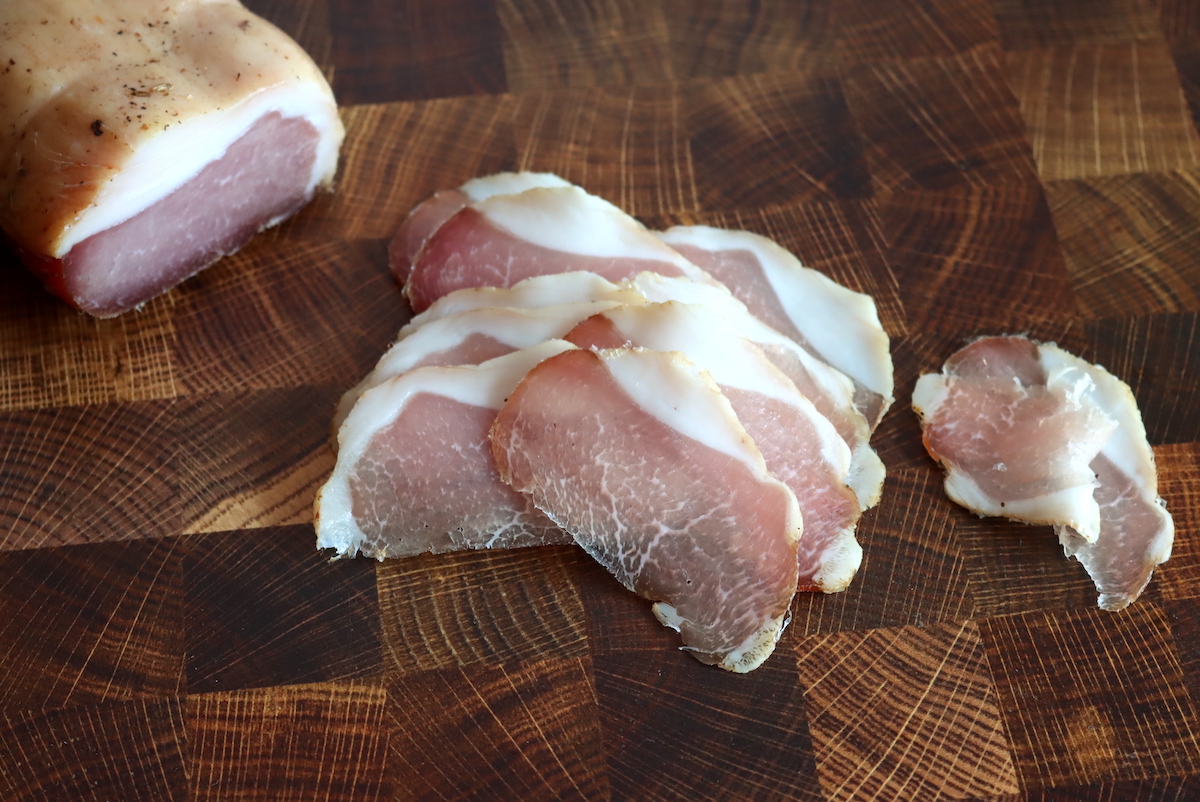
Some people opt to remove the fat cap, and that’s a matter of personal preference. Charcuterie isn’t meant to be lean. The flavor is in the fat, and I think it’s a shame to remove it…but go ahead if you just can’t handle the texture.
(Even still, slicing it thin is the perfect solution to the mouthfeel, as a thin slice will actually just melt on your tongue.)
Beyond the pork, the only ingredients are salt and seasonings.
The salt is weighed at 3% of the weight of the pork loin, and the seasonings are up to you. I’m using a recipe adapted from Salumi: The Craft of Italian Dry Curing. They suggest curing the loin with fennel and orange.
While many types of cured meat are lightly seasoned, loin really does call for aggressive seasoning since it has such a mild flavor on its own. Fennel and orange turned out wonderful, but I think straight black pepper or a smoked paprika-based spice mix would be lovely as well.
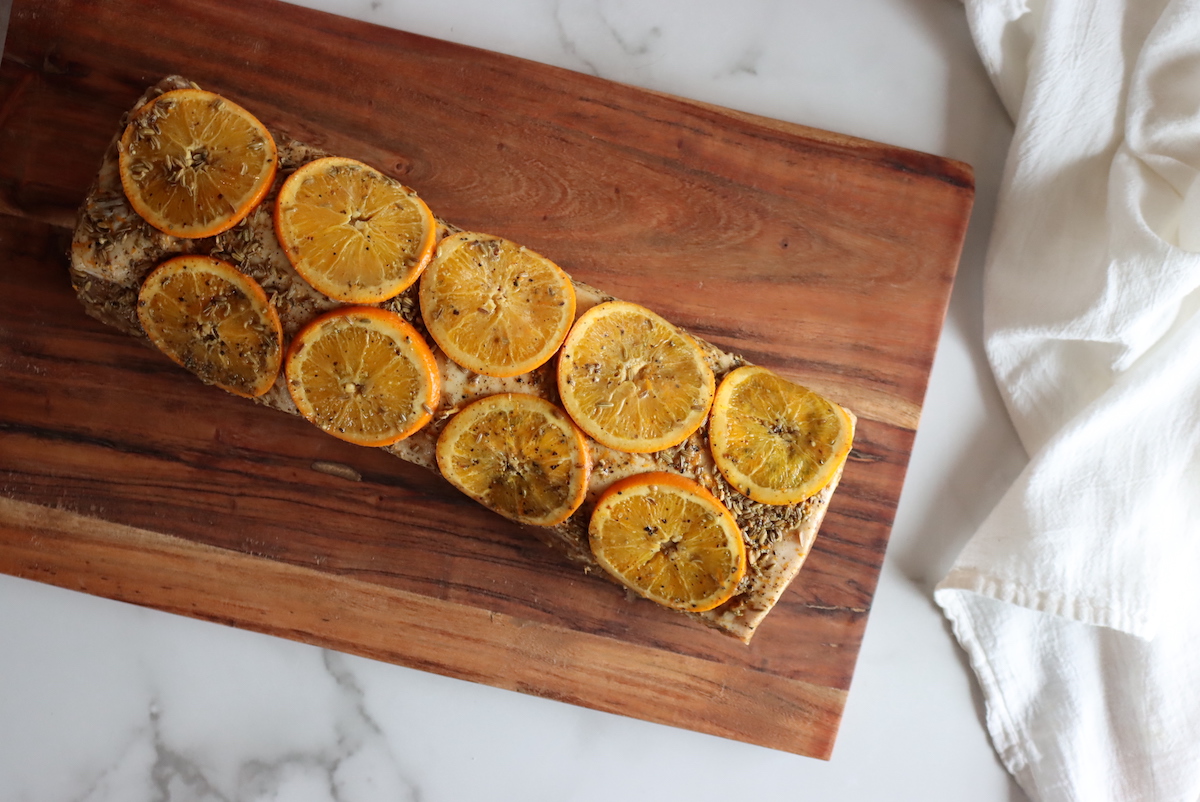
Do you Need Nitrites for Lonzino?
The current consensus in the meat curing world is that whole muscle cuts that are prepared as simple dry cures (not smoked) do not require curing salts or nitrites.
I discuss this in detail in my post on making pancetta, and there’s a great video below that discusses all the ins and outs of when curing salts are necessary.
It’s perfectly fine to add curing salts if that’s your preference, as they impact flavor, texture, color, and other aspects of the cure beyond just food safety. If you do opt for curing salts, you’d use Instacure #2 (not #1) since this will hang for quite a while, and you’ll want to add 0.25% of the weight of the meat.
I did not use curing salts for my lonzino, and it still comes out a lovely shade of pink in the end, with a delicate, mild prosciutto-like flavor (plus plenty of fennel and orange notes).
How to Make Lonzino
Start by trimming the meat to a nice clean tube, ideally with an even thickness all along its length. Cut the ends off clean so there are not thin tails of meat there, and remove any hanging bits or scraps to ensure a clean surface all around.
Weigh the trimmed meat.
A whole pork loin is usually around 4 to 5 pounds, but you can use a smaller chunk of meat or just a section of loin. I’d stick with a minimum of 2 pounds so that you have a meaningful yield at the end.
The cut will lose at least 35% of its initial weight during drying, so keep that in mind when choosing the size of the initial cut.
For simplicity’s sake, I’m going to assume you started with half a pork loin and set the weight in the recipe at 1000 grams. All other ingredients are as a percentage of the pork weight, so 1000 grams (or about 2.2 lbs) makes for easy math. (Pictures are of a 2000 gram whole pork loin, about 4.4 pounds of meat, so a double recipe.)
The cure requires the following:
- 100% Pork Loin (1000 grams for this example)
- 3% salt (30 grams, about 4 to 5 teaspoons depending on the grind)
- 1.5% Fennel, whole (15 grams, about 2 heaping tablespoons)
- 0.75% Black Pepper, coarsely ground (7 grams, or about 1 tablespoon)
- 2 oranges, one sliced thin, the other zested and juiced
You do need to actually weigh everything, that’s important. Use an accurate kitchen scale with weights in grams, like this one. For rough approximations, 30 grams of salt is about 4 1/2 tsp fine sea salt.
Salt varies in weight considerably depending on how it’s ground, so measuring is absolutely necessary to make this (or any other) dry cure. The other ingredients can be rough approximations, but you do need exact measurements for the salt.
Coat the outside of the meat evenly in the cure, and then place the loin in a vacuum sealer bag (or Ziploc bag) and seal. Store in the refrigerator for 10 to 12 days until evenly cured, flipping daily.
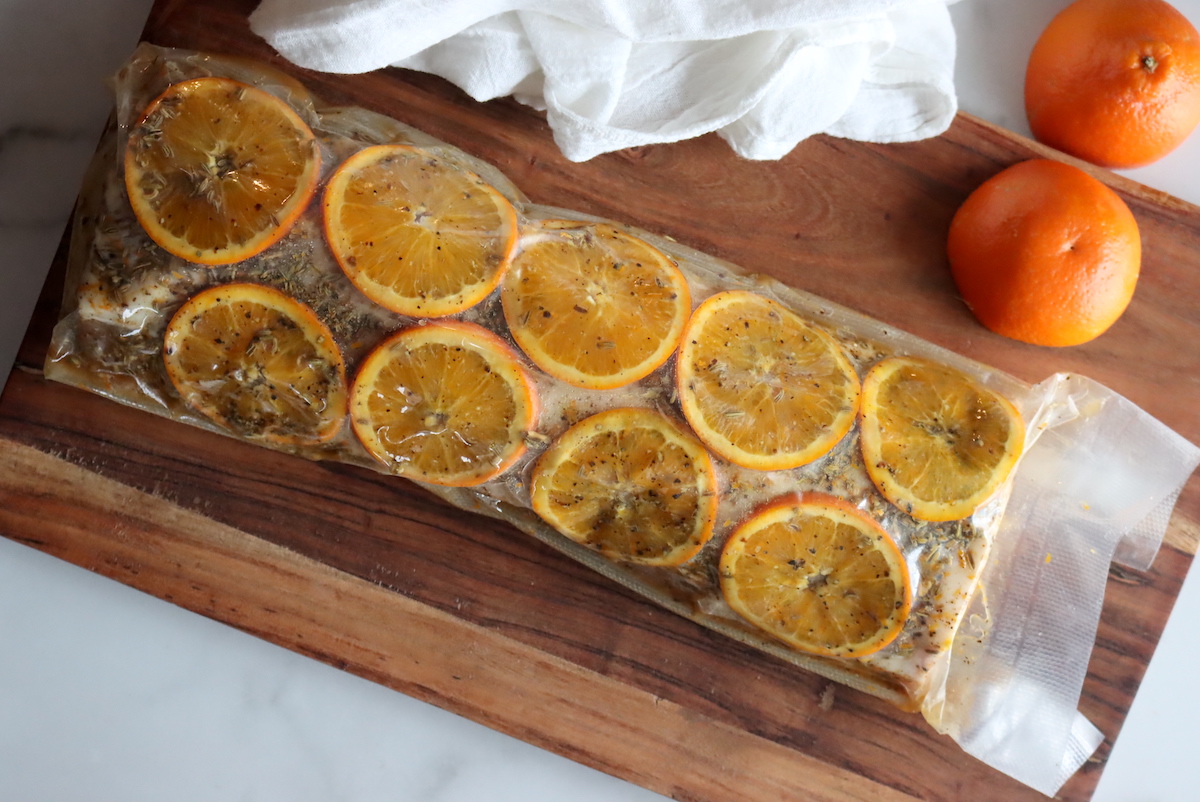
After 10 to 12 days the pork loin will be evenly cured and should be uniformly firm throughout. Remove the loin from the bag.
Generally, rinsing the cure off is optional before curing, but in this case, it’s mandatory. The orange is sweet and juicy on the outside, and it’ll cause mold issues if not removed and rinsed off.
Remove everything from the bag, remove the orange slices and rinse the whole thing under cool running water.
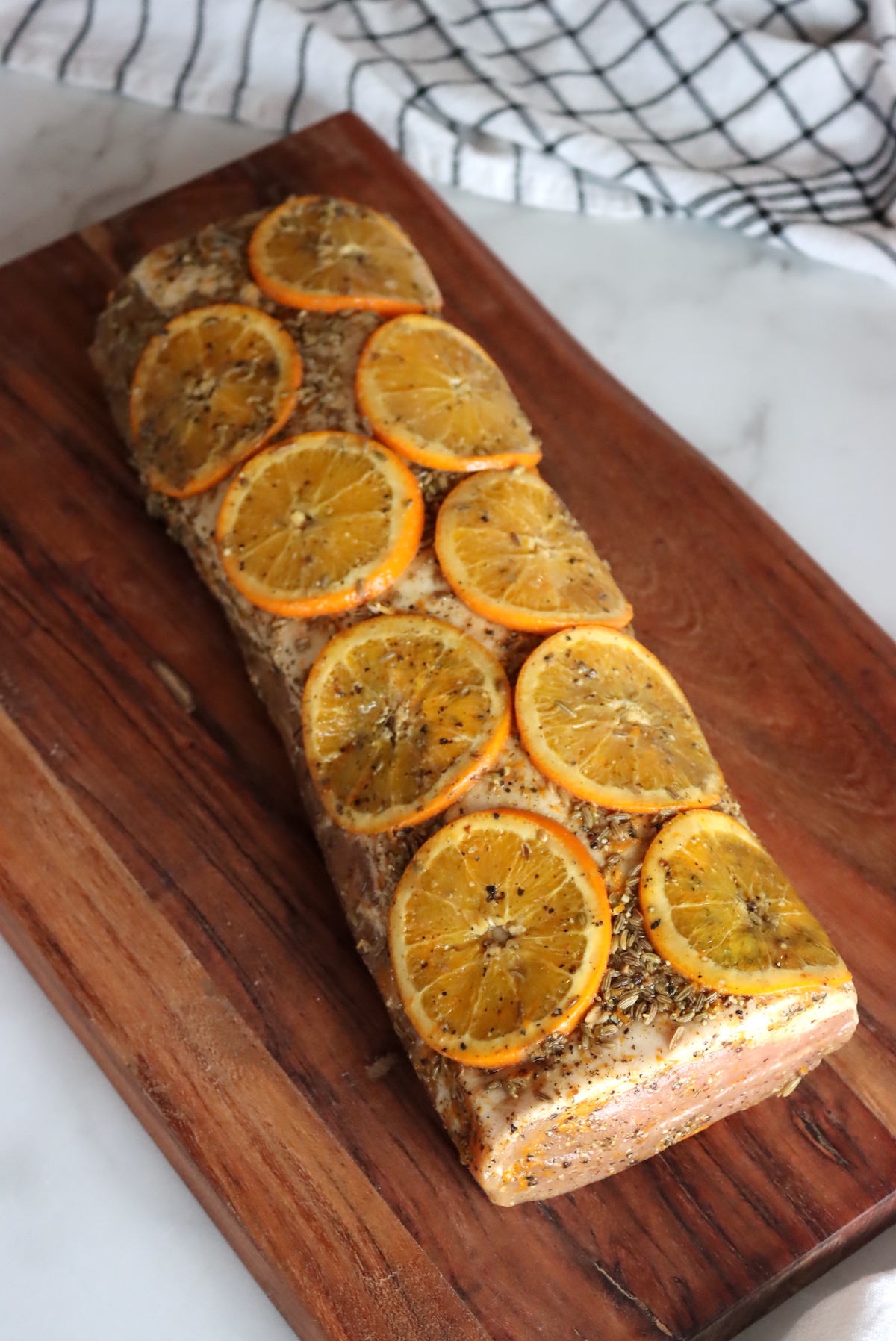
Now it’s time to hang the meat to dry age. This causes it to lose weight, change its texture, and intensifies its flavor. The meat’s actually fermenting during the cure, like yogurt or sauerkraut, so think of it as a live food that’s constantly changing during the curing period.
The microbes we want to cultivate want relatively high humidity, around 65 to 80%. This also helps to slow weight loss during curing, and keeps the loin from getting too dry.
In ideal conditions, the meat should be kept at 50 to 60 degrees F (or 10 to 14 C). Cooler is fine, so long as it’s not frozen, it’ll just take longer to cure.
These days, many people opt to cure meat in their home refrigerators (about 37 to 39 F) and use specialized wraps that regulate humidity. Modern home refrigerators are very low humidity environments, as they’re “frost-free” which means the humidity is removed to prevent frost accumulation.
I actually don’t have a frost-free refrigerator, I have a really unique DC Refrigerator since we have off-grid appliances. My basement stays a consistent 58 degrees though, but humidity is harder to regulate and often drops as low as 40%. I’m using charcuterie wraps from the sausage maker to adjust for humidity.
Simply dampen the meat and then wrap on all sides in an even layer of the plant-based cellulose wraps. The membrane will keep the meat at the right humidity, regardless of the ambient conditions.
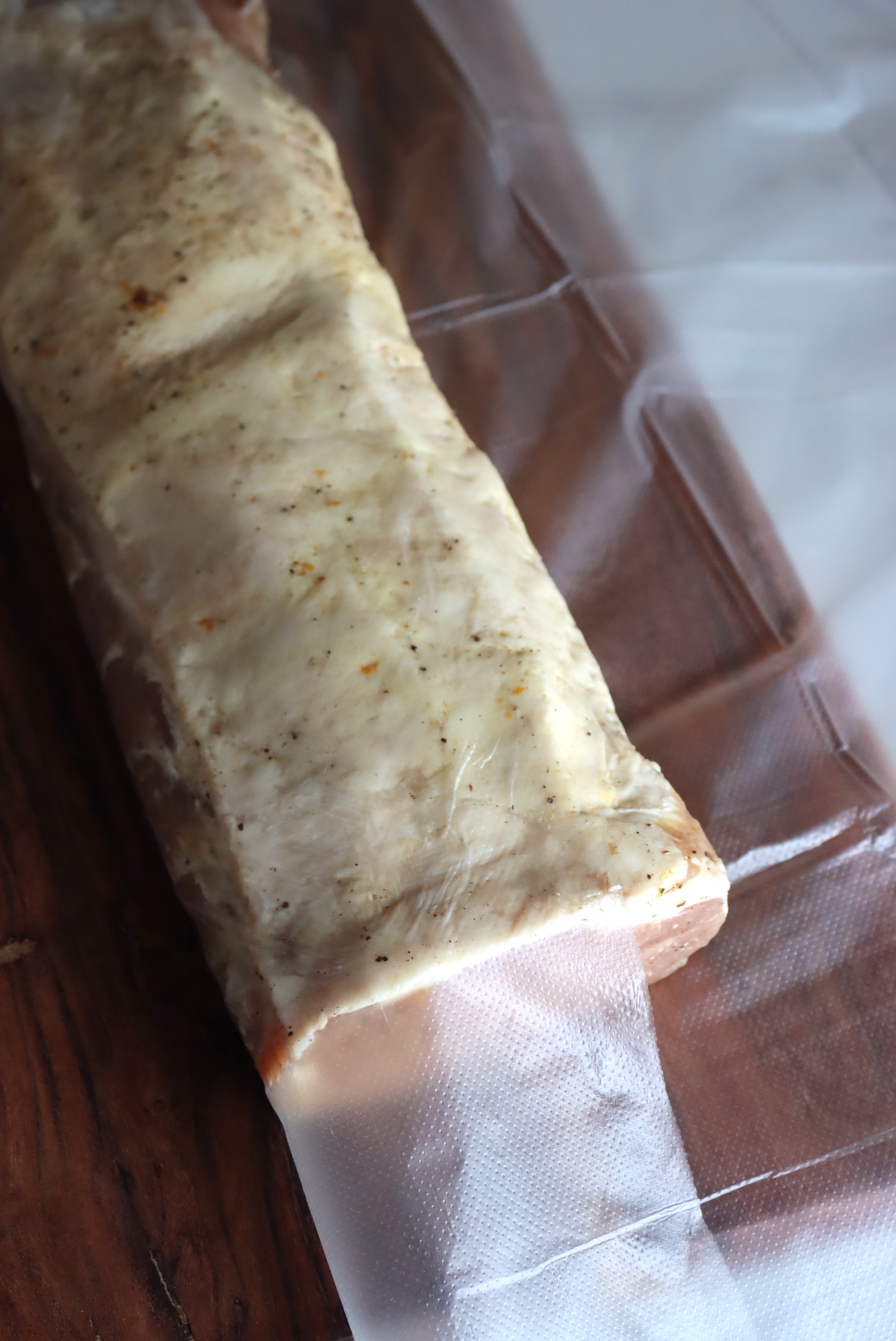
These wraps are completely optional if you’re able to regulate humidity in your aging space, keeping it between 60 and 80%.
If you’re curing in your home refrigerator, be sure to hang the meat from a rack or place it on a grate with a tray underneath (like this one). The loin needs air circulation on all sides to cure properly.
I’m hanging it in my basement, so I’m trusting it up with butchers twine. I’d suggest using the same continuous knot you’d use for a rolled pancetta, and you can see a video tutorial on how to do that here.
If you’re placing it on a rack in the fridge, skip the tying and just wrap it in charcuterie wrap and lay it on the grate.
Weigh the lonzino at this point and record the pre-drying weight (this is important).
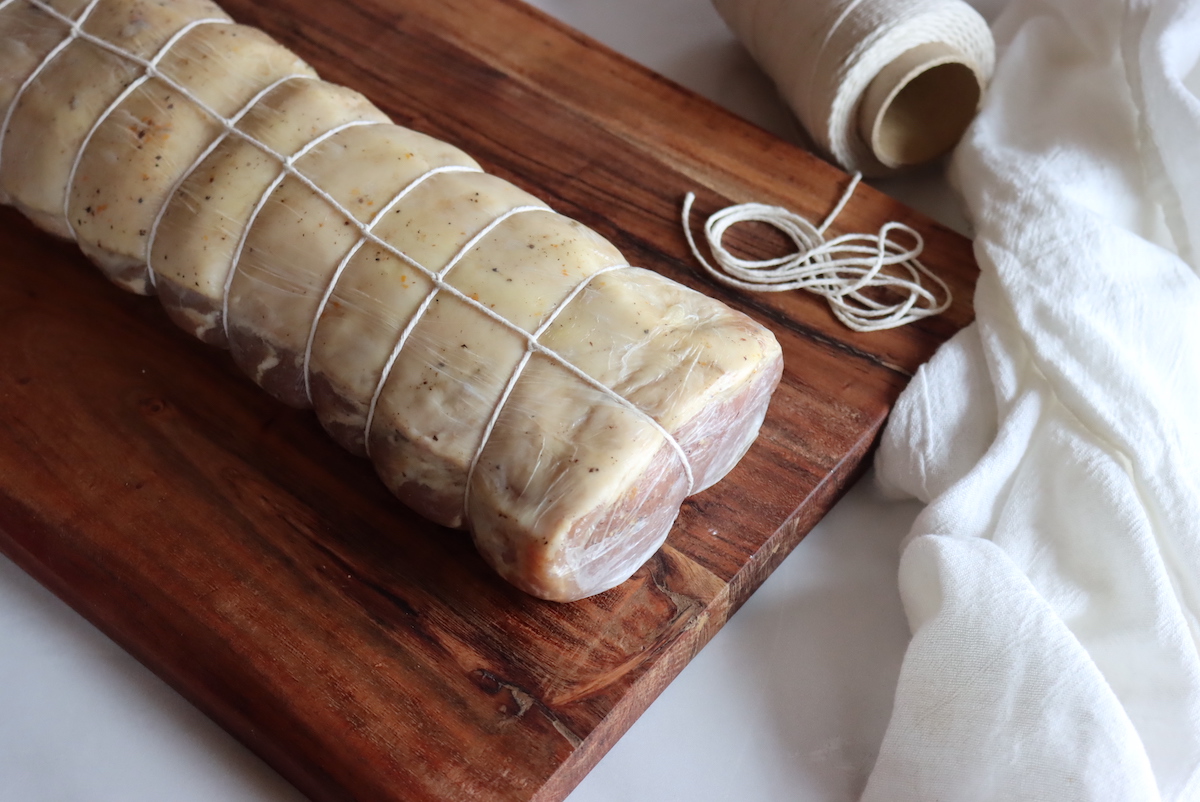
The total hanging time will vary based on your curing environment, but you’re targeting at least a 35% weight loss. (That’s why you weigh the meat on day one of drying.)
Mine took exactly 3 weeks (21 days) to reach a 35% weight loss, when using the humidity controlling wraps. In the refrigerator, it might take a bit longer and cure a bit slower (or faster). In a high humidity curing chamber, it also might cure a bit slower.
Some people opt for a longer cure, lasting up to 6 months, which results in more nuanced flavor development. In that case, you should target 80% humidity in your chamber so it doesn’t dry out too much during curing.
Still, after more than a few months you’re likely to experience a 40 to 50% weight loss and the meat will be considerably dryer. At 45%, it’s still succulent and sliceable, but I’d avoid going too far beyond that.
After 3 weeks and 35% weight loss, mine’s shrunk considerably and you can see that it shrunk away from the truss strings. The charcuterie wrap shrunk right along with it and stayed tight to the meat.
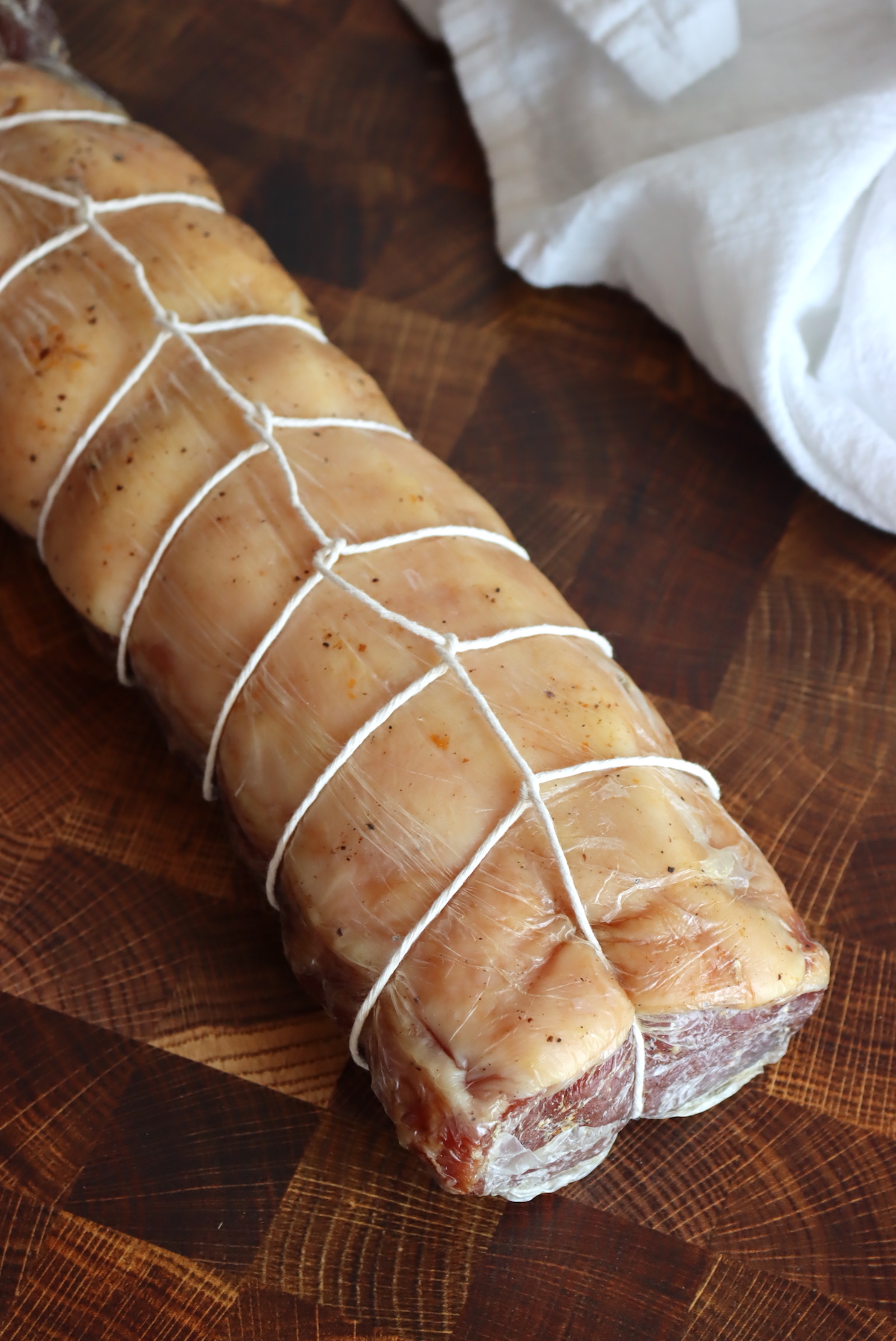
Once the meat reaches 35% weight loss, it’s ready to eat.
Remove the trusting and peel off the charcuterie wrap (if you’ve used one). If you have any trouble getting it off, just wrap the meat in a damp towel and it’ll soften the wrap so it can be pulled right off.
Cured pork loin should be sliced very thin, as thicker slices tend to be “chewy” with cured meats.
You want it so thin that the layer of fat melts on your tongue and just leaves a nutty creaminess to round out the rich, full-flavored meat.
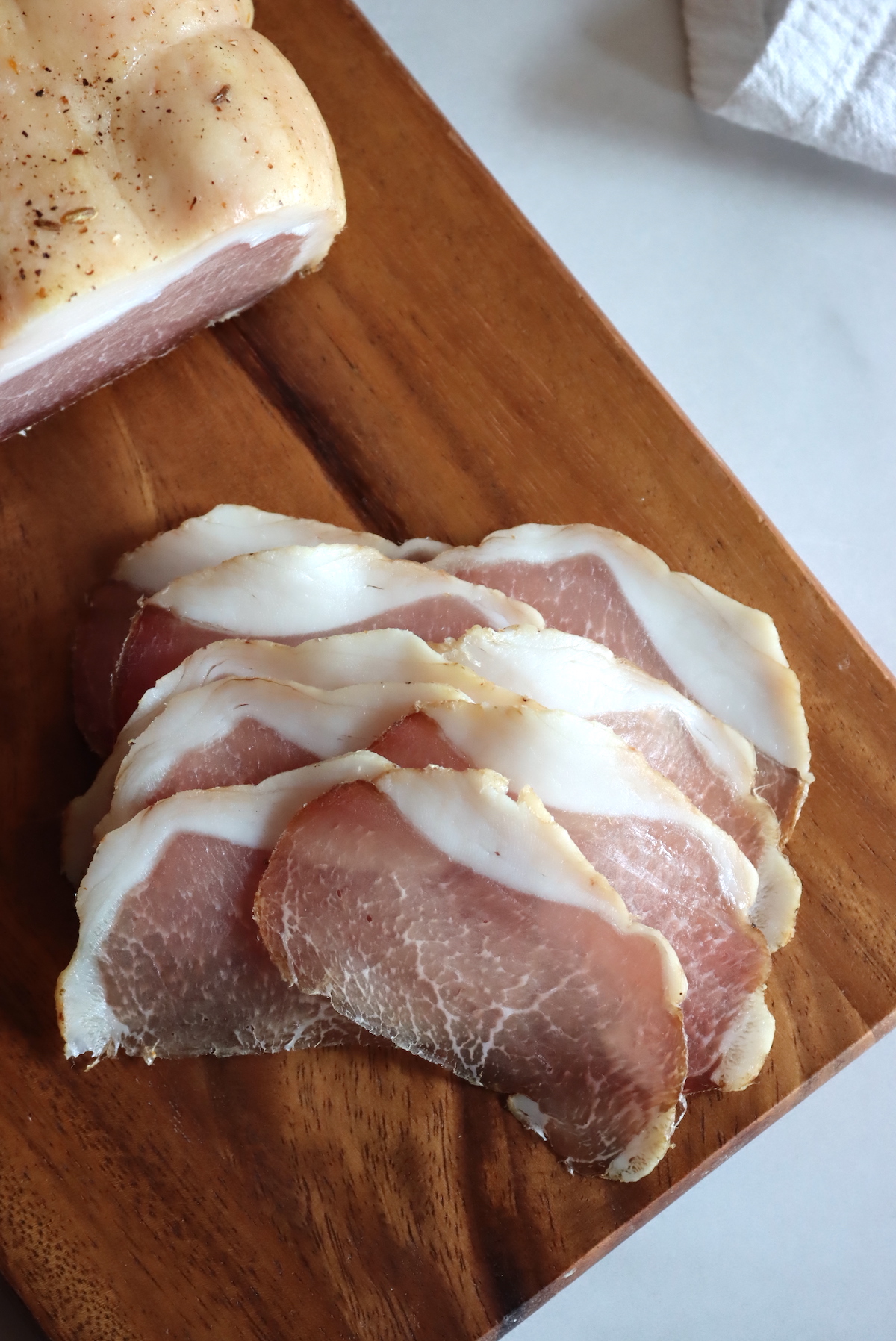
Since I’ve used fennel and orange, this one has a distinctly Italian feel and it’s absolutely incredible.
For more neutral flavoring, try just using coarsely ground black pepper as the seasoning in place of fennel and orange (about 2 to 3%).
Storing Homemade Lonzino
After curing, I’d suggest keeping the lonzino tightly wrapped in the refrigerator. I vacuum pack it in chunks a few inches long so I can open them one at a time.
Wrapped tightly, it’ll keep developing flavor as it slowly cures further in the refrigerator, but it won’t lose more moisture.
It should keep for many months under refrigeration, provided it’s kept sealed and clean. Once you open the packages and start handling/slicing the pieces I’d use them up in a few weeks.
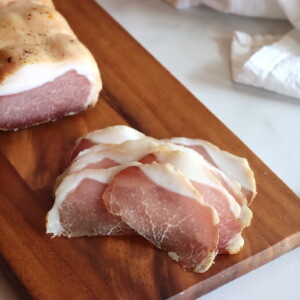
How to Make Lonzino (Cured Pork Loin)
Ingredients
- 100 % Pork Loin, 1000 grams for this example, or 2.2 lbs
- 3 % salt, 30 grams, about 4 to 5 teaspoons depending on the grind
- 1.5 % Fennel, whole (15 grams, about 2 heaping tablespoons)
- 0.75 % Black Pepper, coarsely ground (7 grams, or about 1 tablespoon)
- 2 oranges, one sliced thin, the other zested and juiced
Instructions
- Quantities are given in percentages of the weight of your trimmed pork loin. Everything must be weighed to determine the actual quantities, do not approximate the amount of salt as that MUST be weighed. For reference, I’ve given this recipe for a 1000 gram (2.2 lb) section of pork loin to make the math easier to scale. Most whole pork loins are around 4 to 5 lbs.
- Trim the pork loin to a nice smooth cylinder of meat with no hanging pieces. Remove the fat (optional) or leave it on (as I prefer).
- Weigh the meat.
- Calculate the salt and spices as a percentage of the total weight of the meat. Salt must be 3% the weight of the meat, or slightly more. Do not use less. (Spices can be adjusted to your tastes, but I’ve given tested amounts that give good flavor.)
- Coat the outside of the meat with salt and spices on all sides. Place the salted and seasoned meat into a vacuum sealer bag or ziploc bag. Pour any remaining salt/spices into the bag. Place orange slices and juice all over the loin at this point (if using), and add the rest to the bag. Remove as much air as possible and seal the bag.
- Store the loin in the refrigerator to cure for about 10 to 12 days, or until it’s evenly cured all the way through. The texture will change slightly and it’ll feel a bit firmer when pressed. Error on the side or a longer curing time rather than taking it out early.
- Once cured, remove the loin from the bag and rinse to remove any extra salt/spices.
- Weigh the loin at this point (this is important).
- If using charcuterie wraps to help control humidity, wrap the meat on all sides before trusting to hang.
- If not using charcuterie wraps, be sure you have an area with 60 to 80% humidity to hang the loin. Then truss to hang.
- Hang the loin to cure, ideally at 50 to 60 F, but cooler temperatures like your refrigerator also work. If aging in a household refrigerator, make sure it has good airflow on all sides. This can be accomplished by hanging it from a rack or placing it laying on a rack over a drip tray. Do not place it directly on a solid surface, it must be on a rack or hung for airflow. Do not store it in a location above 60 degrees F.
- Allow the loin to hang until it’s lost 35% or more of its initial weight after curing (recorded at step 7).
- Once cured and dried, remove the charcuterie wrap (if using) and slice very thin to serve.
- Store tightly wrapped in the refrigerator or freezer until needed.
Notes
Home Charcuterie Projects
Looking for more home curing tutorials?
- Guanciale (Cured Pork Jowl)
- Salt Cured Egg Yolks
- How to Make Gravlax (Salt Cured Salmon)
- How to Make Pancetta
Food Preservation Guides
Putting up more than just meat?
- How to Freeze Vegetables (A to Z Guide)
- 100+ Canning Recipes (How to Can Everything)
- Beginners Guide to Cheesemaking
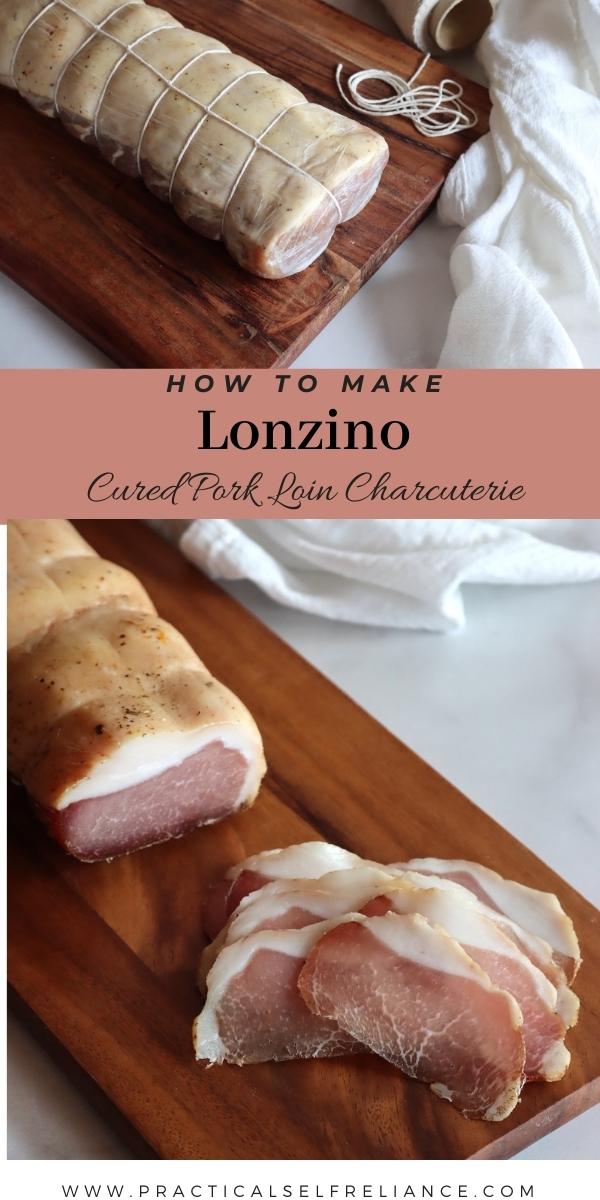
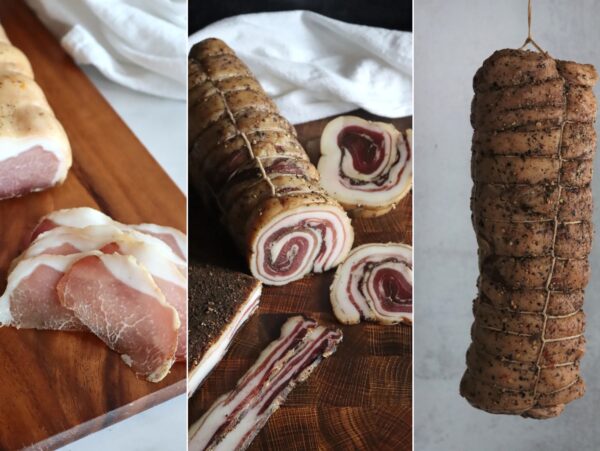
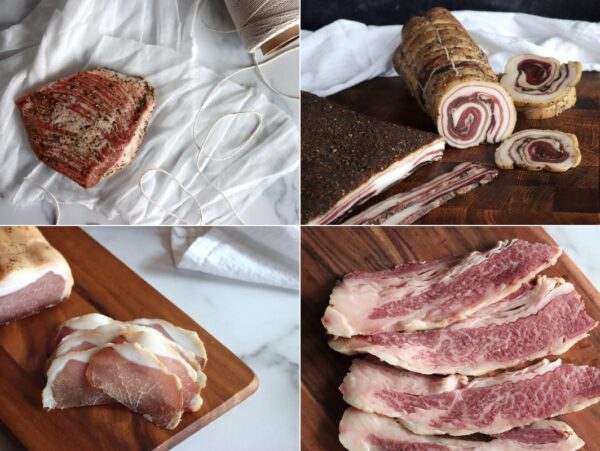
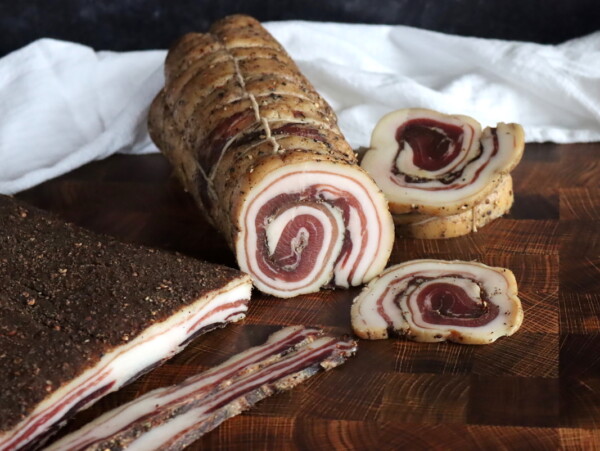
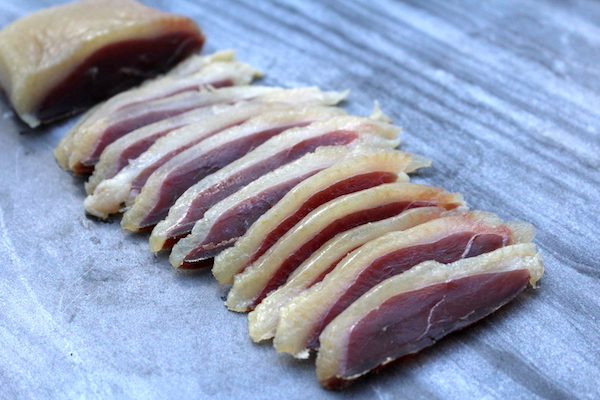










I decided to leave the loin “as is” and not redo the salt and orange juice. It’s now finished it’s fridge curing phase and has been hanging for 10 days. I checked this morning and think I probably made the wrong choice. It’s not smelling amazing.
So I’d definitely say if your marinade leaks — redo the marinade and err on the side of more salt than the recipe requires.
Oh no, I’m so sorry about that. Thank you for sharing so that others can learn. I hope you try to make it again.
I’m making this now. My plastic over the loin has leaked. Should I rinse and repeat? I’m only 3 days into the curing process
Sorry I’m just now getting to this. What did you end up deciding?
I am using a wine fridge. Constant 50 degrees works perfect. I keep 75 to 80% humidity perfectly. My questionis : If I use instacure #2, can I still set this on metal racks vs hanging? can I if I wrap or not in the collagen? Lastly, am I to prick holes all over Collagen if you are recommending to use it? 🤔 Main question is just resting on metal rack? with or without collagen?
At 80% humidity, you don’t need the wrap necessarily. That’s just for if you don’t have high humidity. You can rest it on a rack with a tray under it, just make sure as much of it has air flow around it as possible, and flip it occasionally to dry all the sides.
My recipe doesn’t use instacure of any kind, but you can do that if you like, just make sure you don’t use more than the recommended amount there.
For the collagen that I discussed, it breathes on its own, it’s not a salami wrapping. You don’t poke holes in it.
More importantly than the presence of anti-caking agent is table salt, is the presence of iodine, which an impart a bitter flavor to the lonzino.
It is important to note that, while pink Himalayan salt can be used, it does NOT replace the curing salt, which may also be pink. Actually, conscientious mfrs color Cure #2 yellow, to differentiate it from pink Cure #1 or pink Himalayan salt.
Surprisingly, rice paper & even seaweed sushi wrappers can substitute for expensive collagen dry-aging bags or wrappers, provided the wrapper is held in close contact with the meat & air pockets are excluded. Netting for this purpose is far better than string, since the netting will tend to shrink with the loin as it dries.
Better than fresh orange slices is to paint the loin with a mixture of red wine, liquid smoke, white vinegar & orange extract…before coating with the salt-cure-spice mixture. This will avoid the sugar in fresh orange slices, and minimize mold growth.
This is great information. Thank you so much for sharing.
When you use pork loin it’s Lonza.
When you use pork tenderloin its Lonzino. Sometimes Lonzino is called Filetto.
I am very excited to try this. Curing meat has always felt a bit scary to me. Not understanding the process made me shy away from ever trying. Now to source some really good pork loin, and give it a shot. Thank you so much for all your posts. I simply devour each one, gaining such important knowledge. Keep up the good work.
I noticed you did not cover the outside with good bacteria. Is it because of the shorter hang time (3 weeks)? If I hang it longer is this step highly recommended? Just curious for your opinion if it is possible on a rack instead of hung?
Yes, you can do it on a rack instead of hung, provided you have good air circulation around all sides. As to good bacteria, whole muscle cuts aren’t generally inoculated on the outside; that’s mostly just for salami-type things.
The suggested wrap is not currently available. I would like to make this in my refrigerator. Is there an alternative to the wrap.?
How do you determine the humidity level in the fridge? November in Sydney.Australia.
Jen
It looks like they’re back in stock now. The wrap is really the best way to keep them at the correct humidity. You can purchase a digital humidity gauge but it’s going to be difficult to keep the proper humidity in your home refrigerator.
So I have pork loin and pork tenderloin in my freezer. I gather they are not interchangeable, is that right? The loin seems so very large for having the cure reach the interior. I was hoping to start this today.
You can use either, believe it or not. It’s the same recipe, just be sure you do it by weight since the tenderloin is going to be much smaller. Tenderloin is lower in fat and does not have a fat cap, it also tends to have an even milder flavor. You’ll really want to use seasoning there.
When made with tenderloin instead of loin it’s usually called filetto, but you make it in the same way.
What I used here is pork loin with the back fat still attached, but either is acceptable.
Thank you for the post on how to make “Lountza”. Very accurate. I love lountza. Please note that the island “Cypress” you wrote is wrong. The island is called Cyprus that is where I am from. Thank you for correcting it:)
You’re very welcome. I am so glad you enjoyed it. So sorry about the spelling mistake. It has been corrected. Thanks for letting me know.
What kind of salt do you use?
I’m using fine sea salt, since that’s what I usually have in my kitchen. Any salt without additives works well. (Table salt has anti-caking agents, which you don’t want in cures.) Most kosher salt works (though some still has additives), canning salt is pure salt, and sea salt or Himalayan salt works well. Look at the ingredients list, and so long as it says “salt” and nothing else then it will work.
I’m looking forward to curing some this fall. I’m curious if there are any natural casings I can use in place of the charcuterie wrap… I’m thinking the blind bung of a goat.
Yes, but in that case nitrites are mandatory. Look at recipes for capocollo which traditionally use some kind of wrap around the meat (bladder, beef bung, etc), and you can do basically what they do there but with a loin instead of a neck (copa cut).
When you use an intestine or animal-based wrap you can create anaerobic conditions inside because they don’t breath as dependably as these plant-based ones that are made specifically to solve the humidity issue. They do help regulate humidity nicely, but they also bring along a risk of botulism if you don’t use Insta Cure #2.
Oh, I should also note that if you have a good curing chamber that can maintain at least 60% humidity (ideally closer to 80%) then there’s no need for the wrap in any case, you can just hang it as it is with no wrap (which is what’s traditionally done).
Tried this recipe out with few tweaks. I cured a 1kg pork tenderloin in 2 pieces with the spice rub and oranges in this recipe. I also used the insta cure #2 since this was my first time doing a dry cure. It cured 13 days in the fridge. I the rinsed the loins in brandy, add a rub two tbls each of provencal herbs and black pepper and then wrapped the loin pieces in dry age steak wraps and dried in the fridge for two weeks and it came out fantastic.